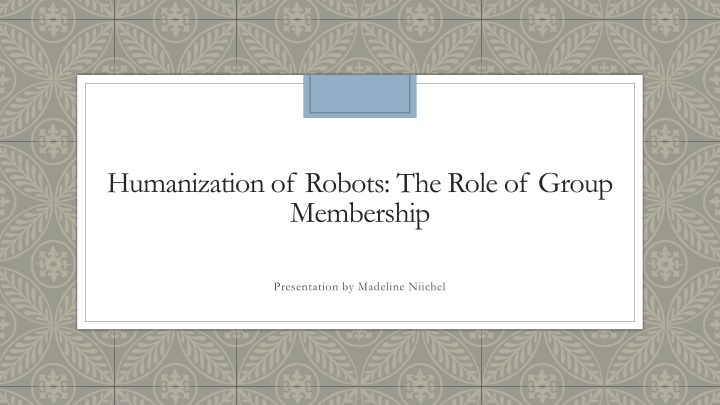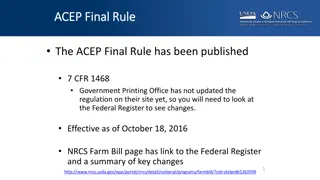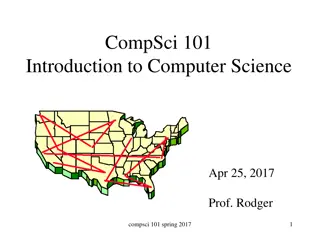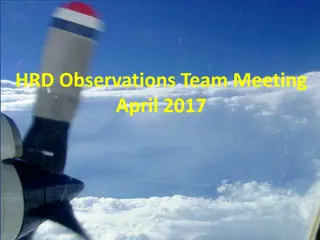
Exploring Humanization of Robots Through Group Membership
Delve into the intriguing study on humanization of robots by Madeline Niichel, focusing on group effects and treatment of robots based on anthropomorphism and human nature. Discover how group membership influences perceptions of robot qualities and human-robot interaction.
Download Presentation

Please find below an Image/Link to download the presentation.
The content on the website is provided AS IS for your information and personal use only. It may not be sold, licensed, or shared on other websites without obtaining consent from the author. If you encounter any issues during the download, it is possible that the publisher has removed the file from their server.
You are allowed to download the files provided on this website for personal or commercial use, subject to the condition that they are used lawfully. All files are the property of their respective owners.
The content on the website is provided AS IS for your information and personal use only. It may not be sold, licensed, or shared on other websites without obtaining consent from the author.
E N D
Presentation Transcript
Humanization of Robots: The Role of Group Membership Presentation by Madeline Niichel
Purpose Treatment of robots sometimes like humans, sometimes not Anthropomorphism: projecting human-like qualities onto an object Assume inverse of dehumanization Legal implications How we protect animals vs. how we protect robots Practical Implications Knowledge about treatment of robots will help us design them to better suit needs of society Current study: group effects and treatment of robots
Background Two dimensions of anthrop.: Human Uniqueness and Human Nature (Haslam, 2006) a.k.a. Haslam s dual model scale Human Uniqueness separates humans from animals (civility, refinement, rationality, morality & maturity) Human Nature separates humans from machines (intuition, agency, spontaneity, cognitive openness & emotional responsiveness) Group belonging members of out-groups considered less human (Haslam & Loughnan, 2014) Spurred current study
Background H ring, Kuchenbrandt, & Andr (2014) Two robots in-group and out-group cooperation/competition Positive evaluation of in-group robot, anthrop. stronger Eyssel & Kuchenbrandt (2012) Two conditions German or Turkish (in- and out-group) In-group judged more favorably, and anthrop. stronger Trovato et al. (2013) Two robots introduced in Arabic and Japanese Positive evaluation of in-group robot, anthrop. stronger
Research Question / Hypotheses Group effects in human-robot interaction? Agent s robot qualities affect its humanness along mechanistic (H.N.) dimension Group membership affects mostly animalistic (H.U.) dimension Based on assumption anthrop. is inverse of dehumanization Group effects in context of our study? Expect to replicate above results
Method Condition Player 1 Player 3 2 x 2 Between-Subjects design Participants 74 TTU students & staff, 51 Females, Mean Age: 23 years Eight conditions Students/robots from University of Texas/Texas Tech University Always TTU student on one side Randomly assigned to one of eight conditions Set up Cyberball program to toss ball 30 times 10 of which go to human player (participant) TTU_student TTU_student TTU_student UT_student TTU_student TTU_robot TTU_student UT_robot TTU_student TTU_student UT_student TTU_student TTU_robot TTU_student UT_robot TTU_student
Method Independent Variables TTU vs. UT Student vs. Robot Dependent Variables Measures of HU and HN HNmanipulation-HNTTU student = HN Difference Score HUmanipulation-HUTTU student = HU Difference Score Individual Differences in Anthrop. Questionnaire (IDAQ) Perceived Awareness of Research Hypothesis (PARH) Ball passes
Method Condition Player 1 Player 3 Testing 1. 2. TTU_student TTU_student TTU_student UT_student TTU_student TTU_robot TTU_student UT_robot TTU_student TTU_student UT_student TTU_student TTU_robot TTU_student UT_robot TTU_student Informed consent and instructions Initial questions regarding robots (IDAQ) Likelihood to anthropomorphize Participant plays Cyberball Questions about other players, demographics & PARH Debriefed and Dismissed a. 3. 4. 5.
Method Cyberball In Action
Expected Results Results give insight into which dimensions are affected Expectation that group membership (TTU vs. UT) affects mostly the Human Uniqueness dimension (animalistic) Based on dehumanization research (Haslam & Loughnan, 2014) Also expect that Student vs. Robot manipulation affects mostly the Human Nature dimension (mechanistic)
Results Using SPSS and the Qualtrics data, descriptive tests were run 2 x 2 Between-Subjects Design, univariate ANOVA for each dependent variable Manipulations did not appear to work as expected
Human Uniqueness Scores Human Nature Scores 0.04 0 0.02 -0.05 0 -0.1 -0.02 -0.15 Mean Differences Mean Differences -0.04 -0.2 -0.06 -0.25 -0.08 -0.3 -0.1 -0.35 -0.12 -0.4 -0.14 -0.45 -0.16 -0.18 -0.5 TTU_student TTU_robot UT_student UT_robot TTU_student TTU_robot UT_student UT_robot
Results Significance found in Individual Differences in Anthrop. Questionnaire (IDAQ) Mean differences in scores In comparison to other TTU student Unlike previous study, we found differences in IDAQ scores Those in both robot and UT manipulations were more likely to anthropomorphize May explain why we got the results we did
Conclusion The data (to date) seems to suggest that there are minimal group effects Participants in I.V. UT & robot group were predisposed to anthropomorphize more See less of an effect when looking at H.U. and H.N. measures of anthropomorphism in D.V. Randomization not sufficient Need to control for individual differences in data analysis Based on means, manipulations may have worked Did not see differences in PARH scores, does not explain what happened with H.U. and H.N. scores
What Was Learned Data collection & analysis is strenuous and tedious Sometimes need to control for differences Randomization was not sufficient In future research conduct some sort of matching procedure Screen for IDAQ scores to account for this effect
Practical Importance If the manipulations worked in this context: better able to leverage the literature about dehumanization Predictions about how people may interact with robots Apply current group effects literature to humanoid robots Overall, interactions with humanoid or human-like robots are better understood Assistive, healthcare or companion robots
References Eyssel, F., & Kuchenbrandt, D. (2012). Social categorization of social robots: anthropomorphism as a function of group membership. British Journal of Social Psychology, 51, 742-731. DOI: 10.1111/j.2044-8309.2011.02082.x. H ring, M., Kuchenbrandt, D., & Andr , E. (2014). Proceedings of the 2014 ACM/IEEE international conference: Would you like to play with me? How robots group membership and task features influence human-robot interaction. DOI: 10.1145/2559636.2559673 Haslam, N. & Loughnan, S. 2014. Dehumanization and Infrahumanization. Annual Review of Psychology, 65, 399-423. Haslam, N. 2006. Dehumanization: An Integrative Review. Personality and Social Psychology Review, 10, 252-264. Trovato, G., Zecca, M., Sessa, S., Jamone, L., Ham, J., Hashimoto, K., & Takanishi, A. (2013). Cross-cultural study on human-robot greeting interaction: acceptance and discomfort by Egyptians and Japanese. PALADYN Journal of Behavioral Robotics, 4, 83-93. DOI: 10.2478/pjbr-2013-0006 JBR
Acknowledgements Special thanks to Dr. Keith Jones and his Graduate student Miriam Armstrong for allowing me to help them with this study, and for being patient with me as I learned and grew throughout this process. Also, thank you to Dr. Pat DeLucia and Dr. James Yang for organizing this REU program. This material is based upon work supported by the National Science Foundation under Grant No. 1559393















